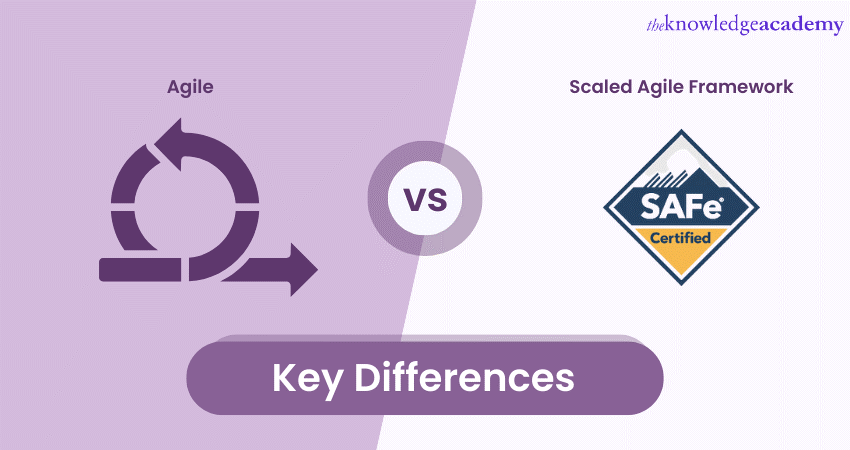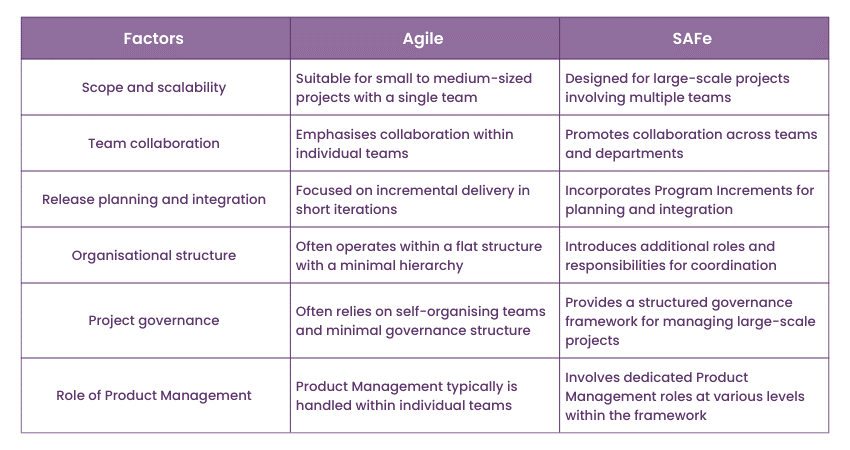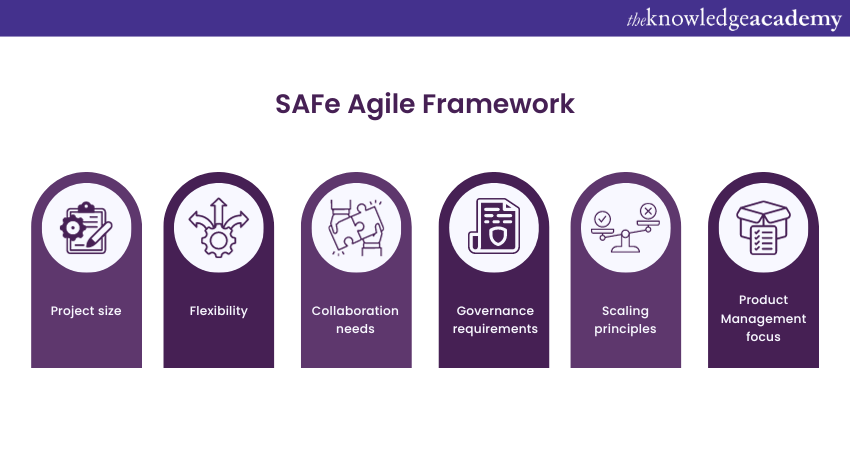We may not have the course you’re looking for. If you enquire or give us a call on +800 312616 and speak to our training experts, we may still be able to help with your training requirements.
Training Outcomes Within Your Budget!
We ensure quality, budget-alignment, and timely delivery by our expert instructors.

Over the years, Agile methodology has gained massive popularity among Project Management tycoons. However, when it comes to large-scale projects involving multiple teams, they often tend to compare Agile vs Scaled Agile Framework.
These organisations often struggle to understand the thin line differentiating Agile vs Scaled Agile Framework. This improper implementation often leads to poor product development and reduces their market image.
However, you can eliminate this confusion by understanding the difference between the two. Read this blog to learn about the key differences of Agile vs. Scaled Agile Framework. Also, find out which is suitable for your team.
Table of contents
1) Understanding the Agile Methodology
2) Introduction to Scaled Agile Framework (SAFe)
3) What is the difference between Agile and Scaled Agile Framework?
4) Which framework is suitable for your project?
5) Conclusion
Understanding the Agile Methodology
Agile Methodology is an incremental approach to Project Management. It emphasises flexibility, collaboration, and continuous improvement. This methodology originated in the software development industry but has since been adopted by various industries to manage complex projects efficiently.
The core values and principles of this methodology are outlined in the Agile Manifesto. This manifesto prioritises individuals and interactions, working solutions, customer collaboration, and responding to change over rigid processes and documentation. Focusing on these values promotes a more adaptable and customer-centric approach to Project Management. The key features of Agile are as follows:
Agile Transformation is the future. Explore how it can change your business in our latest blog.
a) Empowered teams: Agile promotes self-organising and cross-functional teams responsible for delivering high-quality outcomes. They collaborate to foster creativity, ownership and develop a sense of shared responsibility.
b) Iterative development: In Agile, projects are divided into small iterations or sprints, typically lasting two to four weeks. Each iteration involves planning, executing, reviewing, and adapting to feedback.
c) Continuous feedback: This methodology also encourages frequent feedback from stakeholders and end-users. This feedback loop ensures that the project stays aligned with the evolving requirements and provides an opportunity for early course corrections.
Introduction to Scaled Agile Framework (SAFe)
While Agile is a Project Management methodology, Scaled Agile Framework (SAFe) is a detailed framework that extends the principles and practices of Agile to large-scale projects. It provides a structured approach to coordinate and align efforts across multiple teams while maintaining the flexibility and adaptability of Agile methodologies.
This framework addresses the challenges that arise when scaling Agile practices to complex projects with multiple teams, departments, and stakeholders. It offers a set of guidelines, roles, and processes that help organisations Implement Agile principles at an enterprise level. The key components of SAFe include:
a) Agile Release Train (ART): SAFe introduces the concept of an ART, which provides a structure for organising and synchronising the work of multiple teams. This enables them to work collaboratively towards a shared goal.
b) Program Increment (PI): It also operates on a timebox called the Program Increment (PI). A PI is a fixed time period, typically 8-12 weeks. During this period, teams plan, develop, and deliver value increments.
c) Portfolio Level: The framework provides a mechanism for prioritising and funding initiatives based on their strategic value. This ensures effective resource allocation and that the most valuable work is undertaken.
Further, by adopting SAFe, organisations can achieve several benefits, including the following:
a) Improved coordination and alignment across teams and departments
b) Enhanced visibility into project status, risks, and dependencies
c) Increased collaboration and communication among teams
d) Better resource allocation and utilisation
e) Continuous integration and delivery of value to customers
Unlock your potential and drive your career forward with our SAFe Agile Certification!
What is the difference between Agile and Scaled Agile Framework?
Agile methodologies and SAFe are both approaches to Project Management that emphasise adaptability, collaboration, and iterative development. However, the two have a huge difference if one tries to look beneath the surface. So, let’s explore a comparative analysis of Agile and SAFe to understand their key differences:

Scope and scalability
Speaking of Agile vs Scaled Agile Framework, here is how scale and scalability are different from each other:
Agile methodology excels in small to medium-sized projects with a single team. It provides flexibility and adaptability, allowing teams to respond quickly to changes and deliver value incrementally.
Whereas,
SAFe, on the other hand, offers a comprehensive framework for scaling Agile Processes across the organisation. It addresses the challenges of coordinating efforts and aligning work across multiple teams. This makes it suitable for large-scale projects.
Team collaboration
Agile fosters collaboration within self-organising teams. Team members work closely together and with stakeholders. As a result, it promotes effective communication, knowledge sharing, and collective decision-making.
On the other hand SAFe goes beyond team collaboration by emphasising collaboration across teams as well. It provides mechanisms for coordination, synchronisation, and alignment of work across multiple Agile teams. This ensures that teams work together towards a common goal, leveraging synergies and minimising dependencies.
Enhance your understanding of Agile and gain practical skills with our Scrum Certification Training.
Release planning and integration
In Agile vs Scaled Agile Framework, the planning and integration is done differently. This is how it progresses:
Agile projects often focus on delivering value incrementally in short iterations or sprints. Release planning occurs at the team level, with each team independently deciding when to release their increments. Further, integration and coordination may require additional effort due to the decentralised nature of the process.
In contrast, SAFe introduces the concept of Program Increments (PIs). It provides a rhythm for planning, integration, and synchronisation across multiple teams. PIs also enable teams to align their work, synchronise dependencies, and plan releases collectively. Additionally, this structured approach facilitates smoother integration and alignment of deliverables.
Organisational structure
Agile projects often operate within a flat organisational structure with minimal hierarchy. The focus is on empowering self-organising teams and removing barriers to collaboration and decision-making.
SAFe introduces additional roles and responsibilities to facilitate the coordination and alignment of efforts across teams. These roles,such as Release Train Engineers and Solution Train Engineers are taken into account. They help maintain the balance between agility and organisational structure in larger projects. SAFe also acknowledges the need for coordination and alignment while still promoting Agile values and principles.
Project governance
Agile methodologies often rely on lightweight project governance, with decision-making authority distributed among self-organising teams. The focus is on empowering teams to make decisions at the operational level.
On the other hand, SAFe incorporates a more structured governance model, providing clear decision-making roles and responsibilities. It establishes mechanisms for strategic alignment, portfolio management, and program governance. This ensures coordination and control at the enterprise level.
Transparency
In regards to transparency, the dichotomy between Agile vs Scaled Agile Framework stems out in the following manner.
In Agile, transparency is achieved through proper communication, feedback, and visible progress tracking mechanisms. This constant sharing of progress updates and efficient communication, helps the team members to stay on top of the projects or tasks they are working on. These constant updates also help in rectifying errors in tasks or projects.
On the other hand, in Scaled Agile Framework, the transparency is maintained by all teams, programs and portfolios. There are multiple levels in the organisation that take the responsibility of maintaining transparency throughout the organisation. Transparency is maintained not only between team members in the same organisation but also among several cross-functioning teams in that organisation. SAFe uses several mechanisms such as the Program Increment (PI) Planning event where all the teams in Agile Release Train (ART) get together and work on aligning the objectives for a better understanding.
Role of Product Management
The Agile methodology involves a Product Owner who acts as a single point of contact between the development team and stakeholders. The Product Owner prioritises requirements and ensures the product meets customer needs.
At the same time, SAFe expands the role of Product Management beyond a single Product Owner. It introduces the role of a Product Manager who takes a broader strategic view of the product and its market. Product Managers work closely with Product Owners to align product development with the overall business strategies.
Learn how to apply Lean-Agile principles to deliver customer value efficiently. Register for our SAFe® Agile Product Management Training.
Which framework is suitable for your project?
When embarking on a project, selecting the appropriate framework is crucial for its success. The choice between Agile methodologies and SAFe depends on various factors. So, it is better to consider the following factors to make a decision when choosing the right framework:

a) Project size: While Agile suits smaller projects, SAFe is ideal for large-scale initiatives involving multiple teams.
b) Flexibility: Agile provides adaptability and autonomy, while SAFe offers a structured approach with predefined roles and processes
c) Collaboration needs: Agile methodologies offer a great fit if your project requires a high level of collaboration within a single team. While SAFe emphasises collaboration across teams and departments.
d) Governance requirements: Agile has lightweight governance. In contrast, SAFe provides a more structured governance model.
e) Scaling principles: Agile relies on scaling principles, while SAFe offers a standardised and comprehensive scaling framework.
f) Product Management focus: While Agile focuses on a single Product Owner, SAFe expands the role to include Product Managers.
Ultimately, the decision should align with your project’s unique requirements and the organisational context. So, before implementing any Project Management framework, consider the abovementioned factors. This will help your organisation better align its projects with organisational goals.
Unify teams and stakeholders toward common goals. Start your journey to seamless collaboration with scaled agile framework core values today!
Conclusion
In the dynamic world of Project Management, choosing between Agile vs Scaled Agile Framework (SAFe) is vital in determining the success of your projects. Although there is no one-size-fits-all solution, choosing the right framework is crucial to deliver value efficiently.
Learn about Lean-Agile leadership to improve organisational systems. Register now for the Certified Scaled Agile Framework Leading SAFe® 6.0 Training And Exam.
Frequently Asked Questions
Upcoming Project Management Resources Batches & Dates
Date
 Certified Scaled Agile Framework Leading SAFe® 6.0 Training and Exam
Certified Scaled Agile Framework Leading SAFe® 6.0 Training and Exam
Mon 13th Jan 2025
Sat 18th Jan 2025
Mon 27th Jan 2025
Mon 10th Feb 2025
Sat 22nd Feb 2025
Mon 24th Feb 2025
Mon 10th Mar 2025
Sat 22nd Mar 2025
Mon 24th Mar 2025
Sat 19th Apr 2025
Tue 22nd Apr 2025
Sat 17th May 2025
Mon 19th May 2025
Mon 16th Jun 2025
Sat 21st Jun 2025
Mon 30th Jun 2025
Mon 14th Jul 2025
Sat 19th Jul 2025
Mon 28th Jul 2025
Mon 11th Aug 2025
Sat 23rd Aug 2025
Mon 25th Aug 2025
Sat 20th Sep 2025
Mon 22nd Sep 2025
Sat 18th Oct 2025
Mon 20th Oct 2025
Mon 17th Nov 2025
Sat 22nd Nov 2025
Mon 15th Dec 2025
Sat 20th Dec 2025







 Top Rated Course
Top Rated Course



 If you wish to make any changes to your course, please
If you wish to make any changes to your course, please


